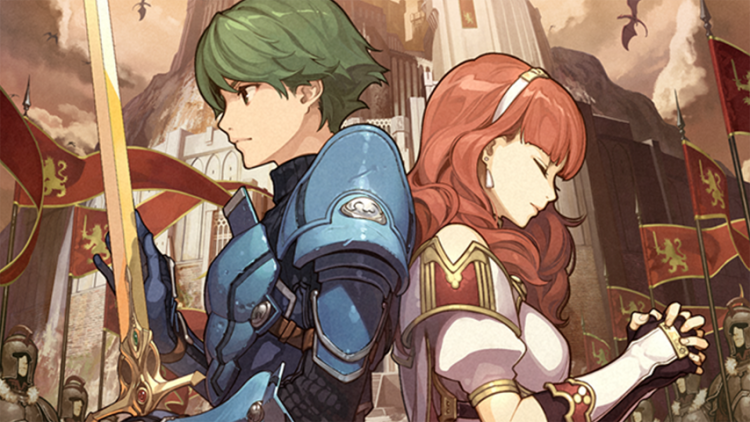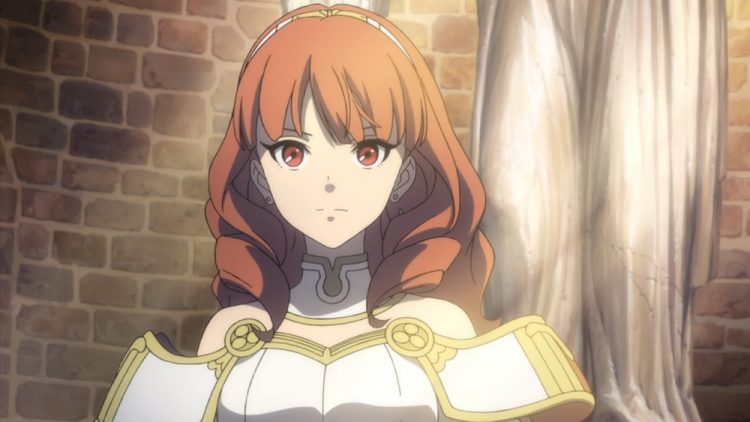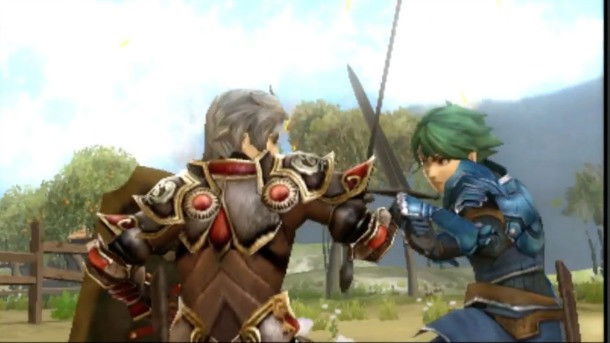Fire Emblem Gaiden is a curious thing. It was meant to be a literal side story to the original game known as Shadow Dragon. In fact, Gaiden literally translates to “side story”. Adding to the curiousness, most of the story in the game was actually told via the game manual. As if that wasn’t enough, it diverged greatly from what the original Fire Emblem did in terms of gameplay. Finally, it never released overseas, so for many of us, Gaiden was another “lost chapter” in the Fire Emblem franchise. Now, decades later, the time has come to embrace the story that we never knew, and let me tell you, Fire Emblem Echoes: Shadows of Valentia was worth the wait.
Game Name: Fire Emblem Echoes: Shadows Of Valentia
Platform(s): Nintendo 3DS
Publisher(s): Intelligent Systems
Developer(s): Nintendo
Release Date: May 19th

I need to say right off the bat that Fire Emblem Echoes: Shadows of Valentia isn’t just a “remake” of Gaiden, the team has stated numerous times that they rebuilt the world, not only graphics wise, but also story-wise, and even gameplay wise. This makes a very complete experience that makes this title stand out as one of the best Fire Emblem titles ever made.
Just from the title screen, you know what this game is about: the main characters Alm and Celica. You see them holding hands and going through a field as children. This very simple opening screen really hammers in from the outset that characters are the focus here, and they hold up that promise. For through the diverging storyline you’ll get to meet a vast army of characters both good and bad, and all of them feel fleshed out in ways that many Fire Emblem games haven’t done before.
Fire Emblem Echoes: Shadows of Valentia is fully voice acted. Only a small percentage of characters, mostly side-quest offering villagers, aren’t voiced. Still, most of the villagers you meet will often speak with a unique voice. It’s really good, and every voice feels true to the characters personality. This even eliminates a big problem that Fire Emblem has a series as a whole, that being the “text wall” that players have to read to get the deep stories and nuances of the world. Because of every line being spoken out, you don’t have to endure the endless scrolling of text because each line is spoken to you. I truly hope this sets the standard for future games in the series both on consoles, and on handhelds.
Going onto the story itself, Fire Emblem Echoes: Shadows of Valentia delves deep into the lives and history behind the land known as Valentia. A land divided into two kingdoms, Zofia and Rigel, and ruled by two gods: Duma and Mila. When hardships strike and the land’s inhabitants start to do things they shouldn’t, it’s up to Alm and Celica to right the ship. The adventure is anything but easy, however.
The first two acts of the game put you in solo stories of Alm and Celica as they rise to try and save their land. But then, once Act III hits, you get to control both of them on separate journeys. We kind of had this in Sacred Stones, but there you had to choose between Eirika and Ephraim and whose story you wanted to experience. Here, you get to see both sides of the story concurrently, and how both sides actually affect the other. It’s a brilliant strategy and one that honestly couldn’t work without the two distinct main characters and their goals. And unlike say, Radiant Dawn, where you played as many groups of people, you aren’t forced to follow one then follow the next. Instead, you go at your own pace until their story (for Acts III and IV) is done, and then if you’re not done with the other, you go there.
Another reason this works is the differences between Alm and Celica as characters. Alm was raised by his grandfather Mycen to be a warrior. While Celica was more-or-less raised in a monastery until she realizes she has to go find Mila. This gives them two separate and unique viewpoints of the world. Alm knows that only the sword can fight back the invading Rigelian empire, while Celica believes that the land of Zofia (of which they both live in) can only be saved with the blessings of the divine dragon Mila. Because of this, they don’t come together to save the world and rather go on their own paths, but that’s a natural thing because of who they are.
True to Fire Emblem fashion, both sides of this conflict have a fun arrangement of characters that join up. From the bickering mages of Boey and Mae, to the eager Gray, to the hilarious noble Claire, to the mercenary with a heart of gold Saber, you will find ones that will become your favorites, and ones that you’ll want to raise to the highest level because you know they’ll be epic in battle. Personally? Gray, Clair (put them together, lol), Clive and Mathilda, Saber, Lukas, Faye, Jesse and more really resonated with me. And yes, there aren’t marriage supports and kids in this game, and that’s fine by me. However, you if you get A supports with certain characters, you do see that they get married after the game ends, which made me smile. Trust me, the supports are worth it no matter who you get to talk to each other.
Another thing I must praise the game for is how the story unfolds and shows that victory also means tragedy. There are several moments that made my jaw drop, and even the “villains” of the game aren’t exactly what they seem to be. Add to that Alm and Celica’s own life-changing struggles, as well as other side-characters you meet, and you got a game that honestly doesn’t pull punches, and I’m eternally grateful for that.
I also want to touch upon the cutscenes, for Fire Emblem Echoes: Shadows of Valentia brings beautifully animated 2D cutscenes to bear, and they are gorgeous, they help sell the grandness of certain conflicts, and it adds to the presentation in a way I can’t fully describe. Just go experience it for yourself.
Now, onto gameplay, Fire Emblem Echoes: Shadows of Valentia preserves beautifully what Gaiden did all those years ago, and even enhances it if you can believe it. First off, Fire Emblem faithful will find that the weapon triangle isn’t here. That also means that bows don’t naturally destroy Fliers. What’s also different is that using Mages actually costs them health for every spell that they use. Oh, and if you hit a foe? You’re guaranteed to do at least 1HP of damage. These may seem like small changes, but they will completely affect how you play the game, and that’s not a bad thing. In fact, it was oddly refreshing at times.
Another “new” aspect was the dungeon crawling adventures you go on. There are shrines and other areas that you need to go into (for various reasons) and along the way, you’ll “encounter” enemies that you can either fight or avoid. Also, there are treasures, statues that will raise the class of your characters, as well as pots and crates to break to get items and coins for future use. Speaking of, in these areas, your characters can get fatigued if they fight too much, meaning you’ll have to be mindful of that else suffer the consequences.
For the most part, these changes work. Dungeon crawling is very fun, and the game makes sure it’s not a gimmick by having key areas be long dungeons. Don’t get me wrong, there are issues. For example, you can only have 10 people in your party in these areas, and if you don’t choose wisely, you’ll have to either start over or go back to the beginning of the dungeon to redo your lineup. Also, some dungeons can be long, and there aren’t many save points, if any at all, which can be frustrating. But overall, it’s still fun.
But for me, two of the coolest and most fun new aspects of gameplay in Fire Emblem Echoes: Shadows of Valentia was the village exploration and Mila’s Turnwheel. The former actually lets you explore the villages you go to instead of just going through them in the story like all other Fire Emblem games do. This lets you talk with villagers, recruit new team members, improve your weapons, and find new items that can help you on your journey. If you’re played Professor Layton, you’ll know the kind of examination aspects you’ll get to do. As for Mila’s Turnwheel, it actually lets you rewind a turn in battles so that you can redo a move without having to reset the whole level.
Now a warning, it’s not unlimited, you have to find Cogs in order to gain another turn. I found 9, but even then, if you don’t play it right, or the luck isn’t in your favor, you can burn through those redos quick. Also, if Alm or Celica dies, you can’t undo that turn, it’s an automatic game over, I personally don’t like that, but I understand why they did it.
Onto things that don’t work. There are some aspects of the game that aren’t explained fully. For example, the Mila Statues (which you will use often) are used to change the class of your characters, cure fatigue, and even look at memories that flesh out the other aspects of the story. But, I didn’t know you could also save at these areas. That’s a big boon as you can find these in the dungeons, but they don’t explain that, so I literally went through the entire game right up until the final level and only then found out about this.
Also, items in the game are tricky. You can’t “buy” items. You find them or receive them in battle. Add to that, you can only equip a singular item onto one character. This causes a dilemma because though characters can attack without weapons, their stats are boosted through equipped weapons. But, if you don’t have a lot of healers, the only other way to heal is through equipping a food item. With every other Fire Emblem game allowing characters to have a few items to equip, this can get annoying. Plus, if you don’t recall which item is equipped, you might doom a character.
Speaking of doomed characters, the RNG gods will not be on the player’s side in this game! Not since Radiant Dawn have I seen characters miss with 80%+ and 90%+ odds so dang much. Not. Cool. Oh, and naturally enemies seem to hit with the lowest of percentages…right…
Finally, there are the maps. On one hand, Fire Emblem Echoes: Shadows of Valentia beautifully uses the maps to create intense situations where strategy is paramount else you’ll lose characters. There were times I spent minutes looking at these maps to figure out a plan before I moved a single unit. And other times I was surprised because I missed something and had to adjust my strategy on the fly in order to win. But…there are some maps that are absurd in their placement of the characters. Now yes, you do get to adjust who goes where, but there are situations that make no logistical sense. For example, in one battle, you square off against a force opposite a river. Your forces are on one side, and they are on another, makes sense right? Right! Well…then you look closer at the map and see that one character is somehow across the river…far away from your own squad. Why? I don’t know! And another has you on the bottom of a plateau, yet a small band of your forces are somehow on top of it…what?
In the end, though, these small beefs can’t stop Fire Emblem Echoes: Shadows of Valentia from being a grand Fire Emblem title. This is truly one of the best Fire Emblem games I’ve played, and I hope that this return to the past of the franchise will lead to new takes on other games we’ve never gotten to play. If you don’t have this game yet, go and get it, you won’t regret it!
Fire Emblem Echoes: Shadows of Valentia Review
Summary
Fire Emblem Echoes: Shadows of Valentia proves that looking back doesn’t mean missing something. In fact, this will definitely go down as one of the greatest Fire Emblem games in my opinion. Great characters, powerful story, challenging combat, this game has it all.
-
Fire Emblem Echoes: Shadows of Valentia Shines from nearly start to finish.






